Dams are built to retain water or prevent water movement. This article discusses the different types of dams around the world.
Depending on the type of materials used, type of structure, structural form, etc., dams can be categorized. There are more than 10 main categories of dams around the world.
This article discusses arch dams, check dams, rockfill dams, earth dams, etc.
The most conventional and simple types of dams are earth dams, which we see most often.
What is a dam
This is the big question that permeates the entire article…
A dam is a structure built to retain water. It can be a combination of several structures or a single structure.
A large dam built for drinking water production and irrigation mainly has a spillway, runoff structures, dam structures, etc.
There are also options for generating electricity. Depending on the intended use of the structure, structures are added to dams.
Essentially, the following structures will be built that connect/are connected to the dams:
- overflow :
It is the main structural structure linked to the body of the dam. Whether the dam is made of concrete, rockfill, earth, etc., a spillway is constructed to control additional water collected in the reservoir and to maintain the reservoir at optimal operating levels. Elements such as keel banks, weirs, gates, control systems, gates, gutters and calming basins are the most important structures of the spillway. Additionally, bridges could be built over spillways, which are generally post-tensioned.


- Guide walls :
There are usually baffles near spillways. One of them can serve as an abutment for the dam, as shown above. The other (on the right) serves as an abutment for the dam. Deflectors are quite large structures, generally found in hydraulic structures.
Most hydraulic structures sit between gravity and retaining wall structures. They are equipped with reinforcements to absorb the forces that occur.
Furthermore, due to limited deflection in design and construction, significantly thicker materials are also used. For example, if the dam body is connected to the baffle and moves due to lateral loading, the dam may fail due to the movement of the dam body toward the wall. Lateral deflection will be greater for these structures if they do not have sufficient lateral stiffness because the support height is too high.
Additionally, the deflection of the spillway side walls must be limited for the gate structures to function properly. Excessive lateral movement can cause mechanical failure of the system.
- Diversion tunnels and plugs :
The construction of tunnels or diversion structures and concrete plugs is common in all types of dams. Dams are built on rivers or waterways to stagnate water. During the construction phase of the dam, the existing water must be diverted to a different direction or must be directed downstream without hindering the construction. If there is solid rock in the area where the dam is being built, a tunnel is built under the body of the dam or in a nearby area to redirect the water.
The diversion tunnel must be designed and built taking into account the maximum flow that can occur in the river. Hydrological studies carried out specifically on this topic form the basis for selecting the size of the tunnel. This data is taken into account in the design of the dam and spillway. Therefore, this data is available and can be used for the construction of the diversion tunnel.


After the construction of the dam, the water flow must be closed. The mechanism used to stop the movement of water or seal the tunnel is called a concrete plug. A concrete plug is a concrete or reinforced concrete filling designed to seal the tunnel. After concreting the plug, mortar is injected to ensure that there are no voids in the concrete, especially in the upper part of the plug.
- Basic sockets : The name itself gives an idea of the structure. Bottom drains are built into reservoirs at the lowest level of the structure. They consist of a sluice structure that allows water to be released.
The main uses are the release of ecological effluents necessary to maintain environmental stability and satisfy downstream use demands, the use of supply water for downstream irrigation systems that existed before the construction of the dam, the release of excess water of the reservoir, use of lowering the reservoir water level for maintenance work, etc.
- Transfer canal and tunnel : Transfer canal is constructed to divert water from one reservoir to another area or another reservoir. If there is a small dam that can collect water, transfer channels are used to direct the water to the main reservoir.
A transmission channel can be an open channel or tunnel . At the beginning of the reservoir there is usually a tunnel. However, beyond a certain distance, it could be constructed as an open canal depending on the topography of the area. Furthermore, building a tunnel is an expensive option.
- Water supply for irrigation : One of the most important purposes of a dam is to use the water collected in the reservoir for irrigation. Irrigation outlets are built like tunnel structures at the beginning of the water supply. Like transfer channels, these structures are constructed in a similar way.
- Recording for power generation and power plant : Most large dams are built to generate hydroelectric power. Hydroelectric energy is one of the sources of energy that does not harm nature.
The collection structures are built together with the dam or in another location in the reservoir that has the appropriate load or in the place where they produce the greatest load. Water head is one of the most important energy that converts into electricity. Depending on the design, plants are built far from the inlet opening, especially if high head is used to generate electricity.


When the discharge occurs at the base, turbines are used when a greater drop is not possible, the power outlet and the plant are very close to the dam. The plant could be built as part of the dam structure, if the dam is a concrete structure, or it could be built together.
- Joint curtain : It is the main obstacle to the movement of water under the body of the dam. Although most types of dams are built on rock foundations, infiltration paths, voids, etc. may be present that allow water to move.
Rock is not impermeable. Voids, cracks, worn areas, etc. must be filled with mortar. The number or pattern of grout holes must match the nature of the rock.


In some dams, a control tunnel or an injection tunnel is also built to be able to carry out the necessary injection work at the infiltration points in the lower reaches, even after the construction phase.
Additionally, the design of an injection curtain reduces buoyancy or buoyancy pressure in the dam. This will significantly reduce dam stability problems.
- saddle dam : In short, saddle dams are one of the types of dams that cannot be as large as the main dam, which is built to prevent water movement when filling the reservoir. The dam forms a reservoir in which water is distributed over a larger area.
The following image, taken from the Internet, shows a saddle dam.


There may be places where water movement needs to be blocked as the water level rises. These small dams are called saddle dams. However, in some situations, a saddle dam can also be a large dam as the reservoir grows.
- Cofferdam
A cofferdam is part of the work involved in most types of dam construction. The construction of cofferdams is not limited to the construction of dams and is quite common in structures below the water level.
As explained in relation to the diversion tunnel, the river must be diverted so that construction work can proceed smoothly in both the dry and rainy seasons.
The dam or temporary structure built across the river is called a cofferdam.
The following figure shows a type of cofferdam built on site.


Although the cofferdam is a temporary dam, it must be designed very carefully to avoid failure. An overflow or failure of the cofferdam will have a significant impact on construction work on the main dam.
Therefore, the likely risk must be minimized by taking into account an adequate flood return period.
The Wikipedia article on Cofferdam also has detailed information on this topic.
Now let's discuss the different types of dams in the world.
Earth dams
Earthen dams are also known as dams. Because earth is used to build these types of dams, they are also called sinkhole dams.
Earthen dams are built using impermeable materials, such as clay. Depending on the design, the waterproof layer may be placed on the core and other material may be placed next to the core.
The following figure shows the typical structure of an earthen dam.


The figure above shows the basic structure of the earth dam. A complete dam can be equipped with additional complements that improve its function and safety.
To avoid them and minimize penetration, the dam core could continue down to the impermeable layer. By constructing a core as described above, intrusion is minimized. However, we cannot completely prevent intrusion.
Therefore, a drain is constructed downstream of the dam. Discharge could occur along the core and away from the dam in a downstream direction, as indicated in the figure above.
The selection of material for the drain must be done with caution. In the final part of the article, under Dams, we discuss the selection of materials for each layer.
According to some findings 33% of dam failures are due to excessive infiltration . Therefore, the selection of dam material and design is of great importance.
There are two main types of earth dams.
- Homogeneous dams : Use the same material as in the following figure to build the dam body. However, other components, such as drains and dam slope protection, are made with appropriate materials.
- Zone type : The main difference between zonal dams is the addition of a central core. Zonal dam construction is more suitable for larger dams.
In addition to the method described above, dams can be categorized as shown in the figure below.


The choice of embankment slope is the decisive factor in terms of stability. The existing embankment of already built dams can be used in the original project.
The stability of the chosen slope must be checked. This can be done manually or calculated using appropriate software.
The best way to analyze these types of dams is to use appropriate software. We can determine the critical safety factor based on different failure levels.
Material selection
Selection of suitable material for earth dam is a very important factor. The following images show the selection of materials for different occasions
- Homogeneous coatings of dam material
- Zoned Landfill Material Envelopes
- Covered filter and drainage material
A similar diagram should be developed for the dam based on the project. The images provided below are a selection of materials based on the gradation of materials. Furthermore, diagrams of a similar nature are being developed for these types of dams.
In addition to this method, other tests such as shrinkage limit, plasticity limit, liquidity limit, etc. can be carried out to ensure material suitability.




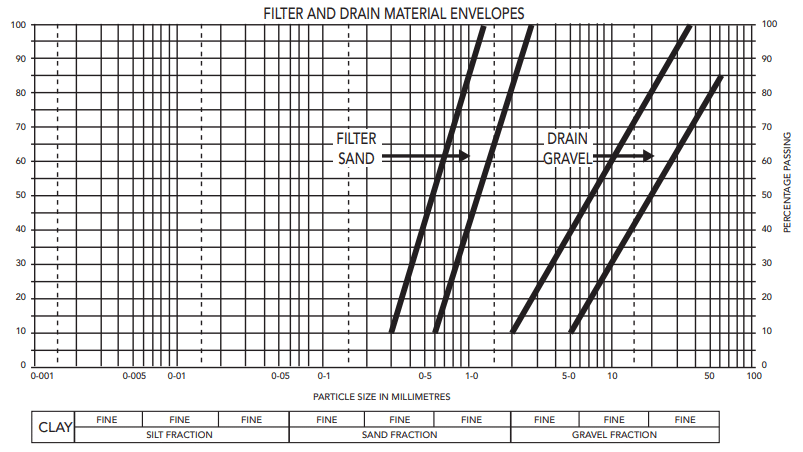

Earth dam failures
-
Hydraulic error : There are mainly five reasons why this type of dams can fail due to hydraulic action.
- When overflowing
- Upstream slope erosion
- Crack formation due to forestry measures
- Lower slope erosion
- Downstream toe erosion
- Seepage Damage : According to some findings, more than 33% of dams fail due to seepage. Therefore, it is very important to pay attention to material selection during planning and ensure sufficient drainage. Additionally, the drainage material must be selected correctly so that it functions as desired. Causes: pipes through the dam body, pipes through the foundation,


The figure above shows the infiltration paths that can be observed in a dam that does not have a core in the middle. A similar infiltration movement can be expected in dams. Therefore, appropriate drainage devices must be provided to avoid dam failures.
Some of the infiltration failure methods can be highlighted below.
-
- Piping through the dam body
- Piping through the foundation
-
Structural errors : Faults that occur in the perineal body fall into this category.
- The upper and lower slopes
- Sudden decline
- Faulty construction
- Inadequate maintenance
- Earthquake failures: Earth dams can fail during earthquakes due to increased water pressure resulting from water movement or due to failure of the dam body.
The following image shows a completed dam.
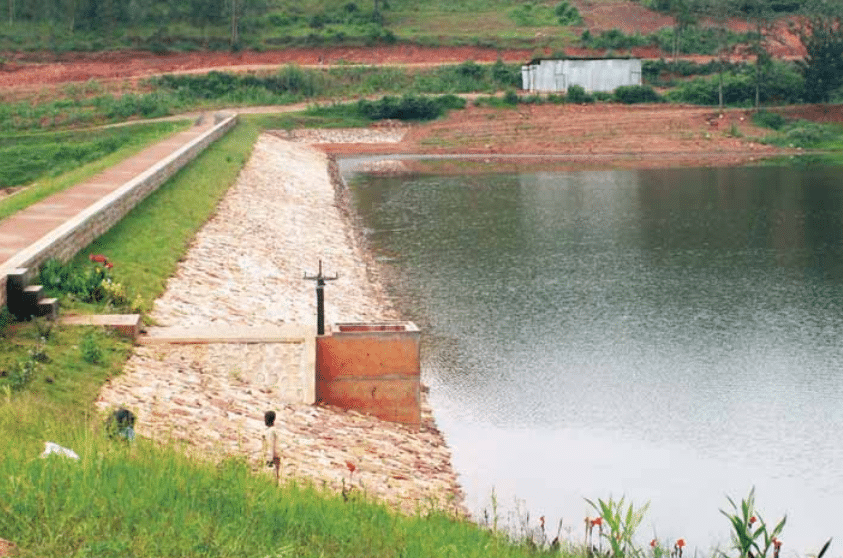

Rockfill dam
Dams built with rocks and impermeable materials. Rockfill dams are more popular, especially when the necessary materials are readily available.
Rockfill dams are zonal dams that include different zones such as core, shell, filters, drains, etc.
Let's see what the main components of these types of dams are.


For ease of reference, each zone has been numbered. They are the following:
- essential
- filter
- crossing
- Downstream filling
- Rockfill
- Rockfill
- thick filling
- Cohesive filling material
Now let us discuss some of the important zones in a rockfill dam.
essential
The dam core is the heart of the dam body that resists the movement of water. It is stabilized by rockfill on both sides of the core.
Clay is used as the core material and its selection is made based on particle size distribution and tests such as yield point, plastic limit, shrinkage limit, etc. Most types of dams built around the world emphasize the consistency and quality of the clay used. for construction, keep tone.
Additionally, permeability criteria are used to ensure that they are within acceptable limits.


As shown in the figure above, the dam core is filled and compacted with suitable materials. Filling is done in layers and each layer is placed between two pillars and compacted.
In the core there are no stage constructions or vertical joints.
As we know, there is an ideal moisture content to achieve maximum compaction. Therefore, water is sprayed in a controlled manner during compaction.
Furthermore, special attention must be paid when choosing the inclination of the core. Information about previously constructed projects and stability requirements can be useful in selecting the most suitable slope.
Furthermore, in these types of dams, stocks are most often built up to continue construction without delay.
filter
The filter is the material placed close to the core. Although we expected the core to be impermeable, it is permeable.
Water flowing through the core downstream must be carefully filtered without leaching or losing core material. Filters are therefore designed to smooth the transition of infiltrated water.
There are design tables based on particle size distribution that indicate the particle size range that should be selected for the filter. A similar type of table provided in Earth Dam Design is available for reference.


The fine material specified next to the core material is the filter material. The filter is also placed together with the dam core material. First, the transition and filter materials are placed. Then the core material is placed between the filter materials on both sides.
There are two filters on each side of the dam, as indicated in typical areas for this type of dam. The upstream filter also protects the core and ensures uniform water movement.
Furthermore, in the event of sudden drops of water, the upstream filter works in the same way as the downstream filter and protects the core from washing out.
Additionally, in such situations, a filter in the supply line can be used to control how quickly the water level in the core drops. If the water level in the core drops suddenly, this will have a negative impact on the stability of the core.
crossing
The transition is the zone in which the shell connection is maintained. It is used to gradually increase particle size.
The filter is made of fine material and the stone fill is made of coarse-grained rock. The transition material is placed in the middle to ensure a smooth material change.
The particle size distribution of transition materials must also be controlled during construction according to design specifications. Similar to filter material, there are tables that should be used during construction when selecting the size of transition materials.
In the illustration above, the metallic fill next to the filter material represents the transition.
Rockfill
Riprap is used to protect the dam shell from water movement.
When waves hit the body of the dam, the mud can break. Wave energy must be adequately dissipated without damaging the dam.
Furthermore, rockfill construction is more important for earthen dams. But even with rockfill dams, building rockfill is a good option if the safety of the dam is taken into consideration.
Furthermore, the production of rockfill for this type of dam does not present major difficulties as long as the appropriate materials are available.
Rockfill
Most of the material used in this type of dam is stone.
As the name suggests, the rockfill dam is built of stone. This is a phased construction in which the individual transition, filter and core layers are placed after the stone fill has been placed.
The rockfill must be sufficiently compacted according to specification. The necessary tests must be carried out to ensure sufficient compaction.
In dam construction, as the height of the dam increases, berms are constructed to increase the stability of the slope.
Stability analyzes for rock-fill dams must be carried out for both normal and exceptional events, such as earthquakes. Since building a dam involves enormous costs, it must be stable despite any likely event.
Planning takes into account the most likely earthquake, the most likely maximum flood, etc.
The slope of the rockfill is the crucial factor that affects the stability of the dam. The selection of the dam slope is made based on the dam profiles available as an initial profile. After selection, the stability of the dam is checked. For dams of this type, the main factor checked is the stability of the slope. The minimum safety factor against usual and unusual loads is checked.
Safety factor against tipping over
The following table indicates which safety factor can be taken into account in the stability analysis.
| project status | Minimum safety factor |
| Comprehensive service level | 1.5 |
| Minimum operating level | 1.5 |
| Empty reservoir | 1.5 |
| Quickly pull down | 1.3 |
| Operating base earthquake | 1.3 |
| The largest credible earthquake | 1.1 |
The above values may vary from standard to standard. However, there should not be a significant difference for these types of dams.
Stability analyzes are performed using computer-based software to obtain more accurate results. However, to achieve the correct results, the real situation must be correctly idealized during the analysis. Furthermore, the behavior of the material must also be taken into closer consideration during the analysis.
We can determine the critical safety factor from the software for the most critical slope. Software like Slope/w can be used to check dam stability.


Safety factor against slipping
It must be checked whether the dam is slipping due to lateral loads.
The minimum safety factor must be maintained against usual and unusual events (earthquakes).
The following restrictions could be adopted as established in EM 1110-2200.
| project status | Overall safety factor |
| Normal situation: Normal operating loads | 2.0 |
| Transitional situations: construction phases | 1.5 |
| Exceptional situation: extreme water levels, earthquakes, etc. | 1.3 |
Leachate analysis
The dam must be checked for seepage movements. This provides a clear view of water movement through the dam body and foundation.
Software such as SEEP/W could be used for the analysis.
The results of the analysis can be used to build the dam. Furthermore, we can determine and study the evolution of water pressure in the dam and structures associated with the dam.
For example, concrete overflow pipes are constructed in conjunction with stone fill dams. Overflow pipes are also constructed as gravity structures. However, due to the height of the water, significant buoyancy pressure is exerted on them. Additionally, there may be stability issues. In some cases, ties are installed to maintain the stability of the dam.
Furthermore, the clay core is one of the most important components of these types of dams. Failure of the core material will cause the dam to fail. Therefore, it is very important to carry out an infiltration study and correctly interpret the results.
Dam instrumentation for dam safety
During and after construction, the performance of the dam must be monitored to ensure its safety. Performance can be monitored and compared to the design to ensure it meets the design.
It is known that the use of dam instruments gives the engineer an accurate picture of the design so that he can compare it with the design of these types of dams.
During the construction of the dam, we can check the dam's settlement using the instrument embedded in the dam body. If unexpected behavior is observed, necessary changes/actions can be taken during construction.
The following dam instructions are carried out for rockfill dams. Some of these instruments are also installed in other types of dams to ensure dam safety.
- Dam Monitoring Study
Topography methods are used to monitor the vertical and lateral displacement of structures.
- Vertical deformation tubes
It provides internal vertical and horizontal displacements. Horizontal displacements are measured manually with an inclinometer and vertical displacements are measured and recorded manually with a magnetic seating probe.
This is very useful for determining absolute settlement and vertical compression (deformation) in dams and foundations.
- settlement cells
Allows vertical displacement or settlement. When installed on the foundation, foundation settlement can be achieved.
Settlement cells are mainly used in the construction phase and in the dam phase to monitor vertical displacements.
If not cared for properly, they will not last more than 5 to 10 years.

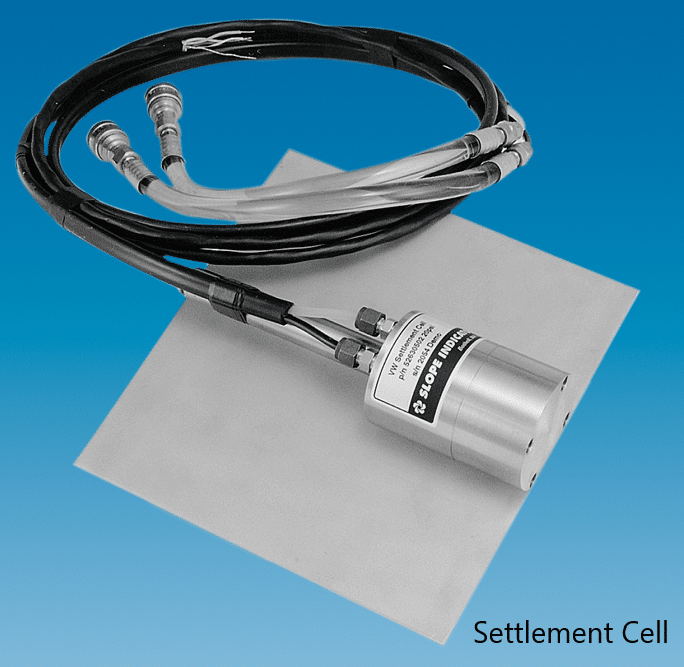
Furthermore, monitoring dam settlement is essential in the construction of these dams.
- Accelerometer
Accelerometers are also called three-dimensional motion sensors.
They are used to monitor the dynamic response of dams to earthquakes.
- Vertical tube piezometer
They are also known as open standpipes or Casagrande piezometers.
Installed to monitor the piezometric water level in the foundation adjacent to the dam area.
In addition, statements are made about the effectiveness of sealing with clay cores and grouting, as well as possible leaks.
- VW water pressure transmitter
The cells are placed in the clay core of a rockfill dam. They monitor the development of irrigation water pressure in the clay core during and after construction.
During construction, they provide time-related data on core consolidation and pore pressure response with reference to design considerations.
After construction, they provide information on the effectiveness of sealing by the clay core material in terms of the pore pressure gradient.
Additionally, VW water pressure transmitters can be used in combination with an open piezometer standpipe to determine the sealing effectiveness of the injection connection to the clay core and possible leaks.
Additionally, VW water pressure sensors are used to check the condition of the filter downstream. We can check possible water levels that indicate clogging in the free drain.
In addition, measurements of surface runoff, as well as reservoir and underwater levels, are also carried out.
Arch dam
According to Wikipedia, an arch dam is a concrete dam that curves upstream in plan. An arch dam is designed so that the force of the water (called hydrostatic pressure) pushes on the arch, causing it to rise slightly and strengthening the structure while pushing it toward its foundation or buttresses.
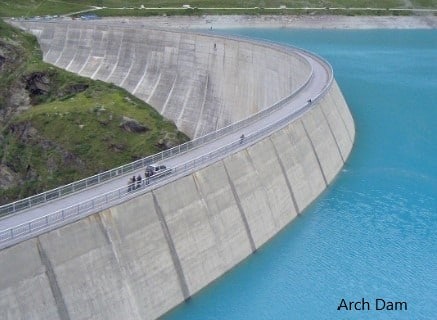

There are various categorizations such as based on thickness, height, geometry, etc. of arch dams.
In this category, we will explore how to categorize different types of dams.
- Arch dams with constant radius
A constant radius is maintained on the outer and inner surfaces of the arch dam. Furthermore, it is also constant at the center line of the dam.
This type of dam is also known as a simple arch dam.
- Variable radius arch dams
Both the inner and outer radius vary with the height of the dam. It starts with a small radius at the base and increases with height.
In this type of dam, the radius varies with the variation in the radius of the dam.
In general, variable radius dams are more economical than constant radius dams. For dams with a constant radius, the thickness remains the same throughout the height. However, for arch dams of variable radius, the concrete thickness decreases with height.
Furthermore, arch dams of variable radius are more suitable for V-shaped valleys.
- Curved double arch dams
Concrete dams with vertical and horizontal curvature fall into this category.
Due to the curved shape in both directions, the design is optimized and the load transfer mechanism is maximized. Furthermore, double curvature dams require comparatively less thickness due to their behavior.
The main disadvantages of this type of dam are the need for a stable foundation and the high construction costs.
As the dam is curved in both directions, formwork preparation is more difficult than for other types of dams.
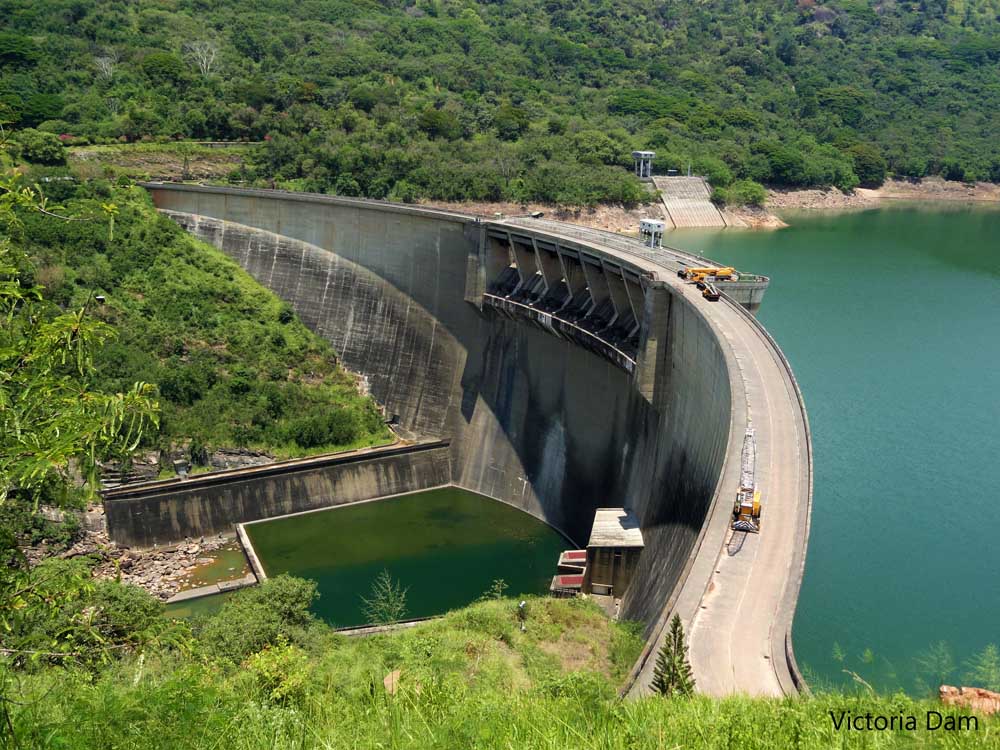

The image above shows the Victoria Dam (Sri Lanka) with double curvature.
There are other categorizations of arch dams based on the thickness and height of the dam. These types of dam categorizations give a better idea of the scale of the project.
Classification based on the relationship between base thickness and height
| Type of dam | Base/height ratio |
| Fine arc | <0.2 |
| Medium arc | 0.2 to 0.4 |
| Thick arc | 0.4 to 0.65 |
| Curved gravity | > 0.65 |
Furthermore, arch dams are categorized according to their height.
Classification based on dam height
| Type of dam | Dam height |
| Low dams | Up to 30m |
| Medium height dams | Between 30 – 91m |
| High dams | More than 91 m |
Advantages of arch dams
- Arch dams are best suited for valleys because they are smaller in width relative to their height. The construction of cantilever gravity dams, such as rockfill dams, may not be economical as a larger base width is required.
- As a comparatively smaller thickness is used for the dam body, the cost could be lower
- Additionally, the use of concrete reduces the elements. Since arch dams are supported by rock masses, no movements other than those caused by creep, shrinkage and elastic shortening occur.
- It is less difficult to find the building material because expensive structures are made of concrete. For rockfill or earth dams, it is difficult to find core materials in large quantities with the same consistency that meet the technical requirements.
Disadvantages of arch dams
- Construction is difficult due to the geometry.
- More technology is needed to simplify construction.
- Installation of formwork is comparatively difficult due to curvature
- Less build speed
- Particular attention is paid to the factors that affect the durability of concrete .
- The long- and short-term effects of creep, shrinkage, and elastic shortening can cause problems.
- Cracks in concrete can become a serious problem
- The rock conditions at the foundation and abutments must be stable enough to withstand the loads that occur.
Support dam
A support dam is a type of weight dam that provides stability through its own weight. It is supported by pillars or other supports placed at regular intervals. Furthermore, these types of dams are not common throughout the world.
Before we continue the discussion, let's take a look at a check dam so you have an idea of what we will discuss next.
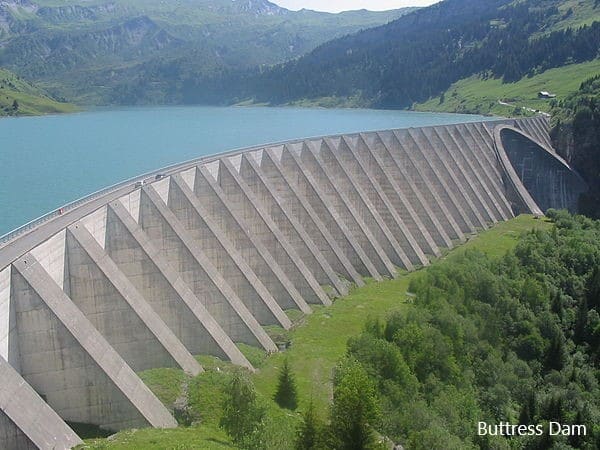

As can be seen in the image above, the dam shell is supported in similar or different ways.
The following points must be highlighted in relation to this type of dam:
- A retaining wall is a gravity dam that provides stability under normal and unusual loads.
- The water pressure exerted on the dam shell is transferred to the foundation through the buttresses.
- Due to the support of the dam body by the buttresses, the stresses in the dam body are reduced.
- Due to the existing support, the strength of the concrete may not be sufficiently utilized.
- As the base area increases, the buoyancy pressure increases. Therefore, the weight of the structure must be increased to maintain sufficient safety factors. (We discussed above a safety factor against tipping and sliding in rockfill dams.)
- However, the existing support reduces the total volume of concrete.
- There may be durability issues with the thin front casing. Therefore, attention should be paid to expiration date requirements.
- The cost of formwork is higher
There are different classifications of retaining walls. This article covers the following. Additionally, there are additional subcategories within each category.
- Rigid containment dam
- Cover plate support dam
- Buttress dam
Rigid containment dam
This is a simpler type of construction. The membrane or inclined deck is constructed together with the buttresses. As they are built in large quantities, great care must be taken with technical aspects such as increasing the temperature of the concrete, laying the structure, etc.
There are essentially two types of retaining walls.
- Multi-arch dam
- Multi-domed buttress dam
Cover plate support dam
It is constructed as a flat slab/deck beam with a series of buttresses. Furthermore, this is also a reinforced concrete structure.
Furthermore, the spacing of the buttresses depends on the height of the dam. As the spacing of buttresses is related to the stability of construction costs, they must be selected very carefully.
As a general rule, the distance between buttresses can vary between 5 and 15 m.
There are basically three types of decking boards.
- Solid cover plate as support dam
- Simple cover plate as support dam
- Support pillar dam with cantilevered roof slab
Buttress dam
The name itself already says something about the type of dam. There is a large dam on the upstream side of the dam. And it is very rare for this type of dam to be built in the world. They could be built for special occasions.
Before we discuss further, let's take a look at the following figure.


The massive head, together with the buttress, provide stability to the dam. It can also be built as a monolithic structure. Additionally, there is no decking like other types of buttress dams.
However, due to the rather high thickness of the concrete that needs to be poured, care must be taken Concrete .
Additionally, functional requirements such as outlets, spillways, etc. they must be planned without major changes to the structural system that guarantees the stability of the structure.
Due to the nature of the structure, it is necessary to increase the dimensions of the head to maintain the stability of the dam.
Furthermore, the stresses are particularly concentrated in the massive head. Therefore, soil conditions must be suitable for this type of construction.
Benefits of retention dam
- Buttress dams are not as heavy as other dams because the additional piers give them greater leverage to keep them from tipping over.
- It can be constructed with comparatively thinner elements.
- Cost savings can be achieved by reducing the thickness of the deck and buttress.
- The deflection of the dam body is comparatively less compared to other dams such as arch dams.
- Significant reduction in concrete volume (1/2 to 1/3) compared to a similarly sized gravity dam.
Disadvantages of the containment dam
- Construction can be difficult compared to a simple gravity dam.
- Using thinner concrete on your deck can cause durability issues due to deterioration of the concrete.
- During the period of operation, special attention must be paid to the safety of the dam.
- Because the loads are concentrated in the foundation and are not evenly distributed, the condition of the foundation rock must be good enough to support very high loads in tall dams.
- Because they are Construction joints In the dam body, careful treatment of the joint is required to Joint stopper where necessary.
Hydraulic Fill Dam
It is a dam that works as a gravitational structure.
Furthermore, it can also be recognized as a type of earth dam due to the materials present in the dam body.
In relation to this type of dams, the following main points can be highlighted.
- The material is transported from the extraction pits and placed at the dam site by water.
- In these cases, the materials mix with water and form mud. This is transported through pipes and deposited close to the dam wall.
- During this process, coarse materials remain close to the surface of the dam, while finer materials migrate to the center and are deposited there.
- Because it uses clay and silt, this process does not require compaction.

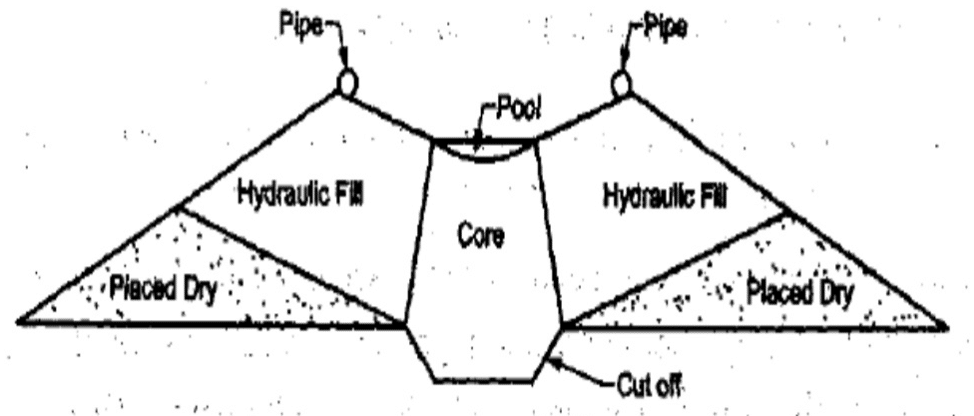
References: Internet, Wikipedia and relevant books.

